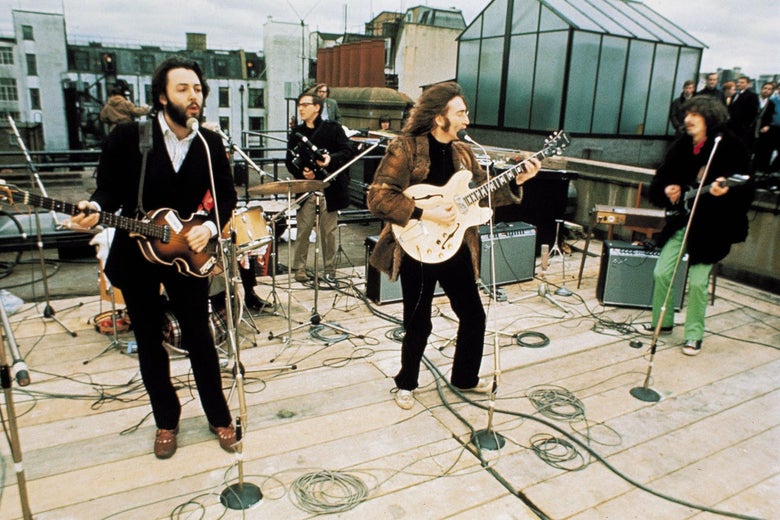He’s one of the two officers who come to Apple Records HQ on Savile Row to try, and mostly fail, to shut down the legendary January 30, 1969, rooftop performance that climaxes both films. But only now do we get to hear the ganglier one—I think he’s PC Ray Dagg, and the other PC Ray Shayler—haggling at length with Apple staff in the office’s front hall, his helmet strap dangling awkwardly at his chin.
Down on the street, some fans ask the film crew why the Beatles aren’t putting on a proper, more accessible show, rather than one they can hear but not see, happening many stories above their heads.
Above all, though, using every modern technique of digital restoration, Get Back becomes an act of necromancy, bringing the Beatles back to life out of those dusty cinematic tombs; in its rich color and sound, it seems almost like it could have been filmed yesterday.
Over the course of three weeks or so, in two different studios, the Beatles are writing and rehearsing for what’s initially supposed to be a TV special, recorded as a live album.
Day by day, we watch time and options for the live event run out, given that Ringo has to leave soon to act in a feature film.
Once they get there, what Paul has been saying proves true: “The best bit of us, always has been and always will be, is when we’re backs-against-the-wall.” All the buildup makes the rooftop show a huge catharsis: When John and Paul hit their harmony on the opening line of “Don’t Let Me Down,” I unexpectedly well up.
Just as the world’s most famous band felt entitled to make a public racket that afternoon in London, today the Beatles is one of a scant few musical cash cows whose nostalgia products are so reliably profitable as to make such absurd demands upon the culture’s attention.
It’s a lot to ask people to sit through hour upon hour of the lads screwing around, nodding off, making inside jokes, occasionally bickering, having the rare serious conversation, and doing one half-finished take after another of the same songs, broken up by jams on 1950s oldies they barely remember the words of.
Directed by hired hand Michael Lindsay-Hogg—who serves as a frequent onscreen goad and even antagonist in Get Back—Let It Be has long been remembered as a dour document of the band breaking up, which is part of why they let it go out of print.
The tracks include not only most of the eventual Let It Be album, but also what will become the core of Abbey Road and even some of their future solo material, not to mention all the snippets of other songs like Lennon’s “Madman” or something called “Suzy Parker” that are never to be heard of again.
It has another section, or perhaps whole song, featuring the same political miscreants telling the Commonwealth, “you’re much too common for me.” We don’t see or hear when the band decides to return to the nonsense “rubbish” lyrics after all, although the confused misinterpretations that came up when the more political lyrics leaked on bootleg tapes years ago may offer a clue as to why.
It is about growing up, as these people are all still doing, and what you gain and lose along the way.
Impressed by a particular keyboard part Billy is laying down, Paul admits, “Coming from the north of England, it doesn’t come through so easy, the soul.” Another time, John and Billy enthusiastically improvise a set of words to the melody of “I Want You ” that are based on Martin Luther King’s “I Have a Dream” speech, which frankly might have made for a better song.
At Twickenham, John seems squirrely and short on ideas, in a time when he’s widely reported to have been dabbling in heroin.
Meanwhile, George is keen on making a solo album, to do something with the backlog of songs the others won’t let on Beatles records, and Yoko Ono is very supportive on that front, perhaps because she’s keen on her and John doing the same.
She’s happy to do some jamming when they’re at loose ends; her howling into the microphone inspires giddy toddler Heather McCartney to imitate her one Sunday, as generations of women in punk and other artists will do in the future.
There are sweet moments between all of them—Paul playing piano while Ringo does a spontaneous soft-shoe, George and John having an animated conversation about watching the newly formed Fleetwood Mac on a late-night TV show, Ringo slyly laying his hand overtop of Paul’s and Linda’s in the control room as they listen back to the rooftop recordings, which turns into a playfight.
“It’s like you and me are lovers,” he says drily, then pauses: “We’ll have to camp it up for those.” Often when John goes into his habitual kooky voices and Goon Show-style surreal comedy routines, the oft-abandoned Liverpool kid in him seems to be defending against such moments of intimacy and vulnerability with Paul.
It’s taken this movie’s long and winding road onto and across our screens to track them—one tragically longer, as it turned out, than what “Two of Us” referred to as “the road that stretches out ahead.” In the flowerpot conversation, Paul tells John he’s sure that, whatever their present differences, when the Beatles are all in their old age, they’ll understand and be singing together again.
